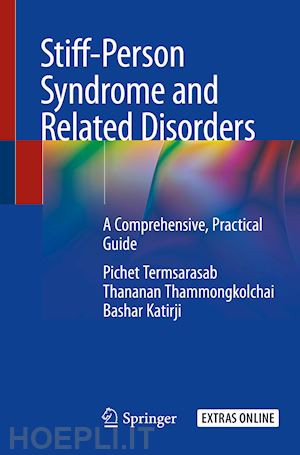1. Historical background of stiff-person syndrome
• The original description by Moersch and Woltman
• Timeline of discoveries of antibodies
• Treatment advances in the field
2. Clinical phenomenology (including diagnostic criteria) of stiff-person syndrome and stiff-person syndrome variants
• How to differentiate stiffness in stiff-person syndrome from other phenomenologies
o Spasticity/hypertonia
o Dystonia
o Cramps
• Clinical features of classic stiff-person syndrome
o Core features
o Associated features including associated autoimmunity
• Diagnostic criteria of stiff-person syndrome and its limitation
• Clinical features of stiff-person syndrome variants
o Stiff-limb syndrome (SLS)
o Progressive encephalomyelitis with rigidity and myoclonus (PERM)
o Overlapping syndromes
o Hyperekplexia: A stiff-person syndrome variant or distinguished entity?
o Confusion about terminology in clinical practice
• Clinical pearls and pitfalls in the diagnosis of stiff-person syndrome
3. Differential diagnosis of stiff-person syndrome
• Central hyperexcitability
o Focal spinal cord lesions
o Toxic/parainfectious causes
o Autoimmune causes e.g. LGI-associated faciobrachial dystonic seizures
o Paroxysmal movement disorders
Paroxysmal kinesigenic dyskinesia (PKD)
Paroxysmal non-kinesigenic dyskinesia (PNKD)
Paroxysmal exercise dystonia (PED)
Secondary paroxysmal kinesigenic dyskinesias
• Paroxysmal tonic spasm in multiple sclerosis
• Other structural spinal cord lesions
Episodic ataxia
• Peripheral hyperexcitability (overview here with further dedicated information on this subtopic in chapter 14)
o Peripheral nerve hyperexcitability syndromes
o Disorders of skeletal muscle membrane hyperexcitability
4. Electrophysiology of stiff-person syndromes
• Electrophysiologic techniques in studying stiff-person syndrome
o Needle electromyography vs. surface electromyography
o Special techniques
• Key electrophysiologic findings in stiff-person syndrome
o Continuous motor unit activity (CMUA)
o Loss of vibration-induced inhibition of H-reflex
o Enhanced exteroceptive reflexes including blink reflexes
o Co-contraction of agonist and antagonist muscles
5. Neurochemistry of inhibitory synapses and clinical applications in stiff-person syndromes
• GABA-ergic synapses
• Antigenic targets of GABA-ergic synapses in stiff-person syndrome
o Glutamic acid decarboxylase (GAD)
o Amphiphysin
o GABAA receptor (GABA AR)
o GABAA receptor-associated protein (GABARAP)
• Glycinergic synapses
• Antigenic targets of glycinergic synapses in stiff-person syndrome
o Glycine receptor
o Glycine transporter 2 (GlyT2)
o Gephyrin
6. Immunopathogenesis of stiff-person syndromes
• GAD-65 vs. GAD-67
In each subtopic below, we will discuss the controversies and current supporting and arguing evidence.
• Is GAD-65 pathogenic or epiphenomenon?
• Cell-mediated immunity vs. humoral immune response
• Role of T-cell vs. B-cell
• Future directions of research in stiff-person syndromes
7. Antibodies in stiff-person syndrome and their correlations with clinical phenotypes
• Eight main antibodies: anti-GAD, anti-amphiphysin, anti- GABA AR, anti-GABARAP, anti-glycine, anti-GlyT2, anti-gephyrin, anti-dipeptidylpeptidase (anti-DPPX)
• Prevalence of these antibodies in stiff-person syndrome and its variants
• Complex correlations between clinical phenotypes and immunophenotypes
• Oncological association/Paraneoplastic stiff-person syndrome
8. Anti-glutamic acid decarboxylase 65 (GAD65)-associated syndromes
• Phenotypic Spectrum of anti-GAD65 antibody syndromes
o Anti-GAD65-associated stiff-person syndrome
o Anti-GAD65 and diabetes mellitus
o Anti-GAD65-associated ataxia
o Anti-GAD65-associated epilepsy
o Other neurologic syndromes associated with anti-GAD65
• Laboratory aspects of anti-GAD65
o Positive high vs. positive low titer
o An issue and caveat about non-unity of reported units
o Laboratory techniques
Radio-immunoassay (RIA)
Enzyme-linked immunoassay (ELISA)
Western blot
Immunofluorescence
• Oncological association of anti-GAD-65 antibodies: Is paraneoplastic work-up required?
• Treatment response and prognosis
9. Progressive encephalomyelitis with rigidity and myoclonus (PERM) syndrome
• Brief history (already discussed in detail in chapter 1)
• Clinical features
• Electrodiagnostic findings
• Associated antibodies
o Anti-glycine
o Anti-DPPX
• Prognosis and treatment responses
10. Emergencies in stiff-person syndrome
In each topic below, we will discuss clinical features, how to recognize and treatment. These features, if not recognized and treated promptly and appropriately, can lead to morbidity and mortality. This topic is particularly important to clinicians managing stiff-person syndrome in the inpatient setting.
• Paroxysmal dysautonomia
• Respiratory issues
• Status spasticus
• Treatment-related emergencies: Baclofen withdrawal syndrome
11. Diagnostic approach in stiff-person syndrome and its variants
• Complexity between immunophenotypes and antibodies
• Targeted approach vs. shotgun approach
o Pros and cons
o Current status of antibody testing
o Issues with existing diagnostic algorithms
• Proposed diagnostic algorithm
• Future directions
12. Treatment of stiff-person syndrome
For each treatment modality, we will review current evidence in the literature including clinical trials (if any), discuss our experience and provide a practical guide in clinical practice. Doses and routes of administration will also be provided, likely in a tabulated form.
• Symptomatic therapies
o Benzodiazepines
o Baclofen
o Other medications
• Immunotherapies
o Steroids
o Intravenous immunoglobulins (IVIg)
Randomized controlled trial
o Plasma exchange (PLEX)
o Rituximab
Randomized controlled trial
o Other immunomodulatory agents including azathioprine, mycophenolate mofetil
o Proposed treatment algorithm
o Future directions
13. Pediatric stiff-person syndrome
• Prevalence
• Reported cases in the literature
• Clinical features
• Difference between pediatric vs. adult stiff-person syndrome
• Treatment outcome
• Caveats in management of pediatric stiff-person syndrome
14. Peripheral hyperexcitability syndromes
Clinical features, differential diagnoses, how to distinguish fr











